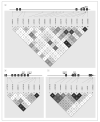Association of alpha-, beta-, and gamma-Synuclein with diffuse lewy body disease
- PMID: 20697047
- PMCID: PMC4727539
- DOI: 10.1001/archneurol.2010.177
Association of alpha-, beta-, and gamma-Synuclein with diffuse lewy body disease
Abstract
Objective: To determine the association of the genes that encode alpha-, beta-, and gamma-synuclein (SNCA, SNCB, and SNCG, respectively) with diffuse Lewy body disease (DLBD).
Design: Case-control study. Subjects A total of 172 patients with DLBD consistent with a clinical diagnosis of Parkinson disease dementia/dementia with Lewy bodies and 350 clinically and 97 pathologically normal controls.
Interventions: Sequencing of SNCA, SNCB, and SNCG and genotyping of single-nucleotide polymorphisms performed on an Applied Biosystems capillary sequencer and a Sequenom MassArray pLEX platform, respectively. Associations were determined using chi(2) or Fisher exact tests.
Results: Initial sequencing studies of the coding regions of each gene in 89 patients with DLBD did not detect any pathogenic substitutions. Nevertheless, genotyping of known polymorphic variability in sequence-conserved regions detected several single-nucleotide polymorphisms in the SNCA and SNCG genes that were significantly associated with disease (P = .05 to <.001). Significant association was also observed for 3 single-nucleotide polymorphisms located in SNCB when comparing DLBD cases and pathologically confirmed normal controls (P = .03-.01); however, this association was not significant for the clinical controls alone or the combined clinical and pathological controls (P > .05). After correction for multiple testing, only 1 single-nucleotide polymorphism in SNCG (rs3750823) remained significant in all of the analyses (P = .05-.009).
Conclusion: These findings suggest that variants in all 3 members of the synuclein gene family, particularly SNCA and SNCG, affect the risk of developing DLBD and warrant further investigation in larger, pathologically defined data sets as well as clinically diagnosed Parkinson disease/dementia with Lewy bodies case-control series.
Figures


Similar articles
-
INDEL Length and Haplotypes in the β-Synuclein Gene: A Key to Differentiate Dementia with Lewy Bodies?J Alzheimers Dis. 2018;65(1):207-219. doi: 10.3233/JAD-180074. J Alzheimers Dis. 2018. PMID: 30040713
-
[Role of genetics in the etiology of synucleinopathies].Rev Esp Geriatr Gerontol. 2011 Oct;46 Suppl 1:3-11. doi: 10.1016/j.regg.2011.10.002. Rev Esp Geriatr Gerontol. 2011. PMID: 22152908 Review. Spanish.
-
Genetics of Synucleinopathies.Cold Spring Harb Perspect Med. 2018 Jun 1;8(6):a024109. doi: 10.1101/cshperspect.a024109. Cold Spring Harb Perspect Med. 2018. PMID: 28213435 Free PMC article. Review.
-
Genetic modifiers of risk and age at onset in GBA associated Parkinson's disease and Lewy body dementia.Brain. 2020 Jan 1;143(1):234-248. doi: 10.1093/brain/awz350. Brain. 2020. PMID: 31755958 Free PMC article.
-
α-synuclein genetic variability: A biomarker for dementia in Parkinson disease.Ann Neurol. 2016 Jun;79(6):991-9. doi: 10.1002/ana.24664. Epub 2016 May 5. Ann Neurol. 2016. PMID: 27091628
Cited by
-
Possible alterations in β-Synuclein, the non-amyloidogenic homologue of α-Synuclein, during progression of sporadic α-synucleinopathies.Int J Mol Sci. 2012;13(9):11584-11592. doi: 10.3390/ijms130911584. Epub 2012 Sep 14. Int J Mol Sci. 2012. PMID: 23109872 Free PMC article. Review.
-
Bridging molecular genetics and biomarkers in lewy body and related disorders.Int J Alzheimers Dis. 2011;2011:842475. doi: 10.4061/2011/842475. Epub 2011 Jul 3. Int J Alzheimers Dis. 2011. PMID: 21760990 Free PMC article.
-
β-Synuclein: An Enigmatic Protein with Diverse Functionality.Biomolecules. 2022 Jan 16;12(1):142. doi: 10.3390/biom12010142. Biomolecules. 2022. PMID: 35053291 Free PMC article. Review.
-
UPDATE ON DEMENTIA WITH LEWY BODIES.Curr Transl Geriatr Exp Gerontol Rep. 2013 Sep 1;2(3):196-204. doi: 10.1007/s13670-013-0053-6. Curr Transl Geriatr Exp Gerontol Rep. 2013. PMID: 25379359 Free PMC article.
-
A Meta-Analysis of α-Synuclein Multiplication in Familial Parkinsonism.Front Neurol. 2018 Dec 11;9:1021. doi: 10.3389/fneur.2018.01021. eCollection 2018. Front Neurol. 2018. PMID: 30619023 Free PMC article.
References
-
- Kosaka K. Diffuse Lewy body disease. Intern Med. 1998;37(1):6–10. - PubMed
-
- McKeith IG, Dickson DW, Lowe J, et al. Consortium on DLB Diagnosis and management of dementia with Lewy bodies: third report of the DLB consortium. Neurology. 2005;65(12):1863–1872. - PubMed
-
- Hughes AJ, Daniel SE, Lees AJ. Improved accuracy of clinical diagnosis of Lewy body Parkinson’s disease. Neurology. 2001;57(8):1497–1499. - PubMed
Publication types
MeSH terms
Substances
Grants and funding
LinkOut - more resources
Full Text Sources
Other Literature Sources
Medical
Research Materials
Miscellaneous

